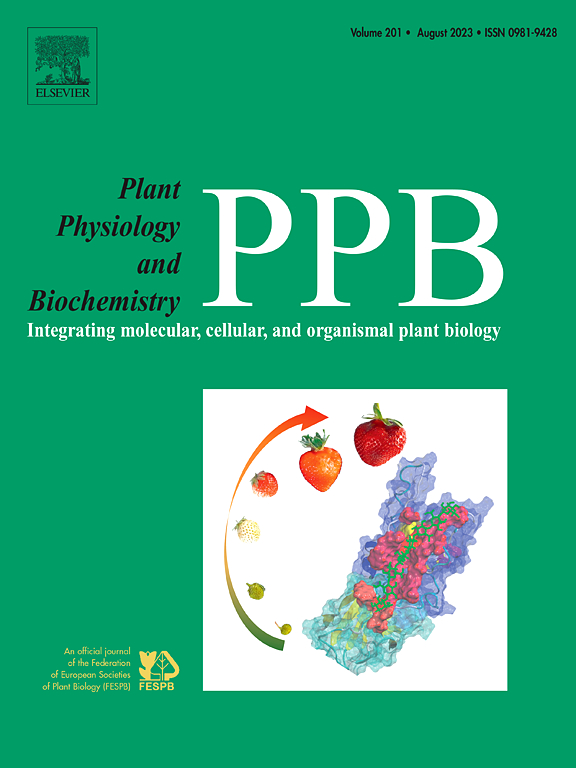gma-miR164a/GmNAC115模块通过影响活性氧清除能力参与大豆对干旱和盐胁迫的适应
IF 5.7
2区 生物学
Q1 PLANT SCIENCES
引用次数: 0
摘要
由microrna和转录因子(transcription factors, TFs)组成的调控模块在植物的逆境响应和适应中起着重要作用。然而,gma-miR164a/GmNAC115模块在大豆干旱和盐胁迫响应中的功能和分子机制尚不清楚。本研究发现,大豆gma-miR164a/GmNAC115模块参与了对非生物胁迫的响应。对大豆毛状根和转基因拟南芥耐盐性和抗旱性的分析表明,gma-miR164a在干旱和盐胁迫响应中起负调控作用,而其靶点GmNAC115在干旱和盐胁迫响应中起正调控作用。采用DNA亲和纯化测序技术鉴定TF GmNAC115在全基因组中的下游靶基因。GmNAC115通过结合NAC识别序列启动子中的顺式元件,激活下游靶基因GmWRKY21、GmAPX6和GmPOD25的表达。GmWRKY21、GmAPX6和GmPOD25在大豆对干旱和盐胁迫的适应中发挥积极作用。此外,GmWRKY21通过结合W-box顺式作用元件正向调节GmAPX6和GmPOD25的表达。综上所述,这些结果表明,gma-miR164a/GmNAC115模块通过去除活性氧维持细胞还原/氧化稳态,从而提高大豆对干旱和盐胁迫的耐受性。本文章由计算机程序翻译,如有差异,请以英文原文为准。

The gma-miR164a/GmNAC115 module participates in the adaptation of soybean to drought and salt stress by influencing reactive oxygen species scavenging
The regulatory modules formed by microRNAs and transcription factors (TFs) play important roles in plant stress responses and adaptations. However, the function and molecular mechanism of the gma-miR164a/GmNAC115 module in soybean responses to drought and salt stress remain unclear. This study revealed that the soybean gma-miR164a/GmNAC115 module is involved in the response to abiotic stress. Analysis of salt and drought tolerance in soybean hairy roots and transgenic Arabidopsis revealed that gma-miR164a plays a negative regulatory role in drought and salt stress responses, whereas its target GmNAC115 positively regulates plant tolerance to these stressors. DNA affinity purification sequencing was used to identify downstream target genes of the TF GmNAC115 in the whole genome. GmNAC115 could activate the expression of the downstream target genes GmWRKY21, GmAPX6, and GmPOD25 by binding to NAC recognition sequence cis-acting elements in their promoters. Moreover, GmWRKY21, GmAPX6, and GmPOD25 play positive roles in the adaptation of soybean to drought and salt stress. In addition, GmWRKY21 positively regulates GmAPX6 and GmPOD25 expression by binding W-box cis-acting elements. In summary, these results suggest that the gma-miR164a/GmNAC115 module maintains cell reduction/oxidation homeostasis by removing reactive oxygen species, thereby improving soybean tolerance to drought and salt stress.
求助全文
通过发布文献求助,成功后即可免费获取论文全文。
去求助
来源期刊
CiteScore
11.10
自引率
3.10%
发文量
410
审稿时长
33 days
期刊介绍:
Plant Physiology and Biochemistry publishes original theoretical, experimental and technical contributions in the various fields of plant physiology (biochemistry, physiology, structure, genetics, plant-microbe interactions, etc.) at diverse levels of integration (molecular, subcellular, cellular, organ, whole plant, environmental). Opinions expressed in the journal are the sole responsibility of the authors and publication does not imply the editors'' agreement.
Manuscripts describing molecular-genetic and/or gene expression data that are not integrated with biochemical analysis and/or actual measurements of plant physiological processes are not suitable for PPB. Also "Omics" studies (transcriptomics, proteomics, metabolomics, etc.) reporting descriptive analysis without an element of functional validation assays, will not be considered. Similarly, applied agronomic or phytochemical studies that generate no new, fundamental insights in plant physiological and/or biochemical processes are not suitable for publication in PPB.
Plant Physiology and Biochemistry publishes several types of articles: Reviews, Papers and Short Papers. Articles for Reviews are either invited by the editor or proposed by the authors for the editor''s prior agreement. Reviews should not exceed 40 typewritten pages and Short Papers no more than approximately 8 typewritten pages. The fundamental character of Plant Physiology and Biochemistry remains that of a journal for original results.

 求助内容:
求助内容: 应助结果提醒方式:
应助结果提醒方式:


